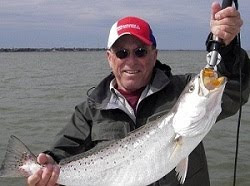Catching Speckled Trout and Redfish with Fishing Guide, Capt. Paul Marcaccio, on Galveston Bay.
Capt. Paul aims to provide each and every client with the trip and experience of a lifetime.
Wednesday, August 8, 2012
Houston Ship channel
Excellent Fishing along the Houston Channel
As the water temperature heats up in excess of 72 degrees, the Houston Ship channel produces solid fishing for anglers willing to understand the adverse conditions associated with fishing there.
This is the time of year to keep the channel in mind as an excellent area for trout, as well as other species such as gafftop, red drum and an occasional jackfish.
Anglers should use live shrimp or croaker. Occasionally, soft plastic shad or shrimp tails work well when trout are actively feeding.
Spoons 3/4 ounce to 1 oz and deep water diving plugs will also be choice baits when conditions merit.
Make use of your fish finder to locate areas that have flats or shell pads and place yourself in a position to drift with the current, as well as with the wind. Hopefully, both will be in the same direction. Keep a watchful eye for slicks and pockets of bait that appear to be nervous.
Once you have hooked-up, it is time to set your anchor. This is not the time to have a short anchor line. For every foot of water beneath your boat, you should put out about ten (10) feet of anchor line. For example, ten (10) feet of fishing depth, requires about 100 feet of line.
Some people may opt to use their drift anchor instead. I’ve experienced tremendous trout fishing with the use of croaker and sometimes live shrimp (more on shrimp later). The use of croaker often tests your patience and willingness to stay in the area. Let me assure you that the results will definitely jump start your heart and fill your ice chest with solid trout to seven (7) pounds.
Methods very with each and every angler and every cast.
Use a slip weight (1/4ounce to ½ ounce) depending on the currents in the area. The stronger the current, the heavier the weight. Use a 10-barrel swivel. Attach a 30-pound test leader from the leader to the hook, (wide gap or circle, use No. 4 hook). The length of the leader should be 12 inches to 18 inches.
Sometimes these trout will hit the croacker in an attempt to kill the bait and take it. Be careful not to set the hook too quickly. Other times, they will inhale the bait and move off and set the hook themselves, leaving you holding on for dear life. There have been occasions when it was necessary to literally jig the croaker much like a shrimp tail to ensure the strike. Keep your croackers separate from other live bait, if at all possible. Make use of a circular live bait well and replace the water as often as you can.
There are some bait camp operators who hold live croaker. The one that comes to mind is Eagle Point Fishing Camp in San Leon. Johnny Valentino does a tremendous job of keeping live croakers at the fishing camp. Please call before you leave home (281-339-1131). Availability of croackers depends on the pressure of the fishermen. Also, Hillman Bait Camp @ the Dickinson bridge . Phone is (281-678-6821) and ask for Mr. Manny……………Mike Morrison and Pat Morrison are the owners.............
As I mentioned earlier, live shrimp is a good bait used under a poppin’ cork anywhere from four (4) to eight(8) feet. The Longer the distance between the shrimp and the cork, the more difficult it is to cast.
Be sure to plan your trips and have alternate spots picked out so that if one area is too crowded or no fish can be found, you can easily venture to another area.
Spoil banks are unforgiving. Ship wakes can virtually remove three (3) to four (4) feet of water in seconds, followed by a huge wave up to eight(8) feet high. This will put a damper on your fishing trip if you are not careful. But, if you insist on fishing in shallow areas along the Houston ship channel, move to deeper water till the ship wake has receded.
Another important thing to look for is the incoming and outgoing ship traffic. Take note of which direction the ship is moving and be ready to pull up your anchor and place your bow into the wake they create, or let out enough anchor line so that the boat can withstand it.
It’s a tough call sometimes, especially when you are on every cast. But, you and your friends are more important than a few fish.
As always, have fun and try not to measure your enjoyment in pounds and inches.
See y’all on Galveston Bay.
Capt. Paul Marcaccio
USCG & TP &W License
Subscribe to:
Posts (Atom)
